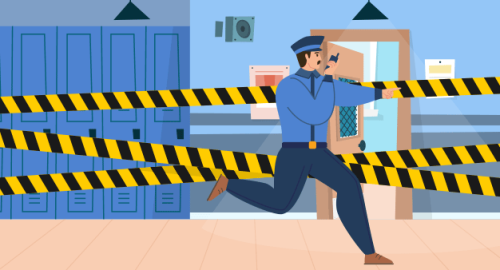Listen to this blog (6 mins)
Washington law HB 1941 mandates that schools have family reunification plans and that schools cannot use live simulations or reenactments of active shooter scenarios in their school safety drills.
The debate over school active shooter drills is not new. Organizations and experts around the nation have voiced concern that some schools—especially those that rely on realistic simulations—can be doing more harm than good. In fact, drills that use realistic simulations can potentially traumatize students, staff, and teachers by triggering past trauma or scaring them so significantly that new trauma is developed.
This is partially why Washington passed updated legislation that restricts how schools conduct these drills. Signed into law on March 17, 2022, the bill states, “Lockdown drills may not include live simulations of or reenactments of active shooter scenarios that are not trauma-informed and age and developmentally appropriate.” Schools must also give participants advance warning of drills.
What Are Simulations or Reenactments of School Active Shooter Scenarios?
Some schools and training programs use life-like simulations when conducting active shooter drills. Examples that schools have used include:
- Firing blank rounds of ammunition or shooting participants with air-soft guns
- Having strangers in masks trying to enter locked classrooms
- Using special effects like smoke or fog to cloud the hallways
- Covering students with fake blood
- Having police in full tactical gear with weapons storm the rooms
These simulation-style drills can have unexpected consequences on participants. “Active shooter drills are associated with increases in depression, anxiety and fears about death among children as young as five years old, to high schoolers, their parents, and teachers,” Rep. Amy Walen, D-Kirkland said.
What does the Washington Law Say About School Safety Drills and Reunification Plans?
The drills must teach students at least these three functional drill responses:
- Shelter-in-Place, which involves students sheltering in their classroom or current location (indoors) to limit their exposure to harm
- Lockdown, which isolates students and staff from threats of violence (note: these are the drills that cannot have active shooter simulations per law updates)
- Evacuation, which moves students and staff out of the school building/campus and away from the threat or hazard
Schools are required to document the date, time, and type of each drill. Schools should work with local emergency management agencies and first responders to conduct one tabletop exercise and functional exercise, as well as two full-scale exercises within a four-year period.
A full-scale exercise can focus on reunification. As a core part of school emergency management, Washington mandates that schools have a plan to reunify students with approved guardians. Schools are also required to teach staff notification and alert procedures, as well as how to use emergency supplies.
How Can Schools Conduct More Effective Drills?
While school shootings may be rare, it’s still important to train your school community so they can keep themselves safe. Family-student reunification is also imperative to practice. Reunification may be necessary after violent incidents, weather events, bomb threats, or even things like plumbing or HVAC issues.
Schools can follow these best practices to train participants in the appropriate response:
- Ensure the Curriculum is Appropriate for Every Student: Training should include evidence-based, age- and developmentally-appropriate curriculum that gives teachers and students the confidence to respond to any kind of situation. It’s critical that schools also have lesson plans for students with disabilities.
- Practice the Curriculum with Thoroughly Planned Drills: Drills should be part of your emergency operations plan (EOP) and developed in partnership with first responders, mental health professionals, and safety team members. Schools should communicate drills ahead of time and have an announcement when the drill begins (e.g., “This is a drill, not an actual emergency”) to decrease the likelihood of someone thinking there’s a real threat.
- Focus on Building Confidence and Empowering Participants: When students and staff know how to keep themselves safe, it helps build their confidence and reduce their worry and anxiety around attending school. Following age and developmentally appropriate training, especially when it’s built on the empowerment theory, “can empower kids against [the violence],” Adam Coughran, co-founder of Safe Kids Inc., explained on an episode of School Safety Today.
Follow Industry Leading Best Practices to Keep Everyone Safe
Raptor has partnered with Safe Kids to provide Raptor customers with a no-cost, 1-school year subscription to the Safe Kids H.E.R.O. training curriculum. Schools can practice drills with help from Raptor Drill Manager, which enables schools to:
- Schedule drills and track compliance
- Quickly verify each building’s drill activity
- Notify staff before drills
- Analyze reports for insights on where they need to improve
To streamline the entire reunification process and ensure students are reunited with authorized guardians, schools can leverage Raptor Reunification.
Get started on your free training subscription and learn more here.





